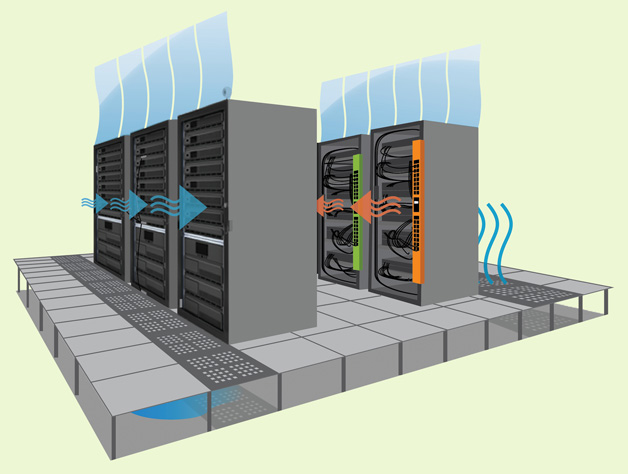部落格
主頁 » 部落格 » Types of Data Center Cooling Techniques
Types of Data Center Cooling Techniques
Posted on October 31, 2017 by Gento

Having proper temperature management in your data center is absolutely vital to maintain the functionality of the equipment. Having an excess of warm air and humidity within your data center can create a financial burden for your business that can be avoided. In this guide, you will become more knowledgeable on the types of cooling techniques that you can implement in your data center.
Free Cooling
Free cooling is a cost-effective way to ensure that your data center’s temperature flow is properly functioning. When this technique is used, the cooling used are minimalistic and reduce the overall expenditures for cooling. This method consists of two systems known as air-side economization and water-side economization. Air-side economization uses air from the outdoors to regulate the equipment’s coolness. This technique has its flaws since it can potentially allow pollutants and moisture from the outdoors to enter into the data center.
Chilled Water System
Liquid cooling can be more efficient and direct in its cooling techniques. This is due to the fact that chilled water can be directly targeted to the desired area, without it being necessary to supply cool air to all areas of the facility. With the chilled water technique, the CRAH is connected to a chiller. As the chilled water travels through coils, it engulfs the heat and deposits it into the chiller. Once the water returns to the chiller, it merges with condenser water flowing through a cooling tower.
Pumped Refrigerant
This method pumps chilled water through a heat exchanger and utilizes a cold pumped refrigerant to draw out the heat. The Pumped Refrigerant technique provides savings since it has the capacity to transmit energy from servers and it allows for humidification to be greatly reduced.
Indirect Air Evaporative System
With this technique, an air-duct that is connected to an indirect air evaporative cooler is utilized. This method is energy efficient and uses weather from the outdoors to cool the facility at times when it is cooler than the temperature inside. This air is used to add cooler air to the airflow within the data center.
Data Center Organization
Optimizing the organization and placement of your data center equipment is an easy and cost-efficient way to ensure that your data center is meeting the temperatures it needs to maintain productivity. Efficient organization for optimum data center temperatures includes hot/ cold aisle arrangement, containment, rack placement, cable organization, and usage of blanking panels.
Hot/ Cold Aisle Arrangement
Managing hot and cold aisles is a typical way to sustain temperatures in data centers. Without separating hot and cold aisles, the air within the data center will experience “mixing”, which is an inefficient use of energy. With air mixing, the equipment does not have the opportunity to be submerged in the optimal temperature that it needs to function. The hot/cold isle method is implemented by positioning racks so that the lanes are divided by hot aisles and cold aisles.
Containment
Through the hot and cold aisles, containment can also be implemented to isolate the hot and cold air from the racks. When containment is in use, the HVAC units can perform more efficiently. For this system, the hot air should be monitored to ensure that the hot aisle is not over-extended.
Rack Placement
The placement of the racks can minimize the heat circulation from rack hot spots. Within the rack, the hottest location is located at the top of the rack. To ensure optimal cooling, you can arrange your racks by organizing their components so that the heavier equipment is located on the lower racks. Since larger equipment circulates the most air, a lower rack placement will ensure that less hot air is dispersed at the top of the rack.
Cable Organization
Maintaining cable organization not only allows your cables to be neater and easier to manage, but it also ensures that the cables are not obstructing the data center’s airflow. It is a small step towards allowing your data center to optimize its airflow.
Blanking Panels
If your racks have unused space and your data center is not utilizing blanking panels, excess heat is being emitted into your data center’s airflow to accommodate rack space that is unoccupied. By using blanking panels, the hot air will be blocked from entering your data center’s airflow, proving greater cooling efficiency.
Environmental Monitoring
In addition to these techniques, it is important to be able to monitor and manage your facility in real-time. In order to ensure that your data center equipment is operating at the optimum temperature, environmental monitoring is important. With environmental sensors, you can monitor and manage your data center’s airflow, humidity levels, temperature, air pressure, and hotspots. More information about environmental monitoring can be found here.
Other Blog Posts
- 從資料中心失效對企業帶來的骨牌效應──探討感測器的重要性
- Posted on November 5, 2023
- 更高規格的電源要求加速AI市場成長與Raritan PDU的採用
- Posted on October 11, 2023
- 資料中心服務中斷次數減少,但停機的代價仍舊可觀
- Posted on September 20, 2023
- 意見調查:資料中心面臨能源使用與人力短缺困境
- Posted on September 20, 2023
- Raritan安全切換器:相容於Secure NIAP 4.0的桌上型KVM
- Posted on September 20, 2023
訂閱
近期活動
- New Zealand Cloud & Datacenter Convention 2022
- 3 November 2022, 9am – 4pm • Grand Millennium Hotel, Auckland, New Zealand
- Data Centre World Singapore
- 12th – 13th Oct 2022
- Korea Cloud & Datacenter Convention 2022
- 6th Oct 2022
- Philippines Cloud & Datacenter Convention 2022
- 4th Aug 2022
- JANOG50 Meeting Hokkaido
- 3th – 15th July 2022
Raritan最新新聞
- Legrand 使用兩大創新智慧型機架 PDU 重新活化資料中心產業
- Posted on May 1, 2023
- Exclusive interview丨How does Huizhou upgrade its manufacturing industry?
- Posted on December 2, 2021
- Raritan 發表 MasterConsole® 數位雙電腦切換器
- Posted on February 18, 2021
- Legrand Data, Power and Control Division Announced as Finalist in Six Categories at DCS Awards 2020
- Posted on November 9, 2020
- Raritan 新款智慧機櫃控制器 (SRC) 可智慧管理資料中心與關鍵任務設施的環境與安全性資訊
- Posted on November 9, 2020